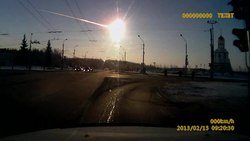Chelyabinsk meteor
|
(image link)
Meteor fireball seen from Kamensk-Uralsky where it was still dawn, in an oblast north of Chelyabinsk |
|
| Time | 09:20 YEKT (UTC+06:00) |
|---|---|
| Date | 15 February 2013 |
| Location | |
| Coordinates | 55°09′00″N 61°24′36″E / 55.150°N 61.410°ECoordinates: 55°09′00″N 61°24′36″E / 55.150°N 61.410°E |
| Also known as | Chelyabinsk meteorite |
| Cause | Meteor air burst |
| Non-fatal injuries | 1,491 |
| Property damage | Over 7,200 damaged buildings, collapsed factory roof, shattered windows |
The Chelyabinsk meteor was a superbolide caused by an approximately 20-metre near-Earth asteroid that entered Earth's atmosphere over Russia on 15 February 2013 at about 09:20 YEKT (03:20 UTC), with a speed of 19.16 ± 0.15 kilometres per second (60,000–69,000 km/h or 40,000–42,900 mph). It quickly became a brilliant superbolide meteor over the southern Ural region. The light from the meteor was brighter than the Sun, visible up to 100 km (62 mi) away. It was observed over a wide area of the region and in neighbouring republics. Some eyewitnesses also felt intense heat from the fireball.
On account of its high velocity and shallow angle of atmospheric entry, the object exploded in an air burst over Chelyabinsk Oblast, at a height of around 29.7 km (18.5 mi; 97,000 ft). The explosion generated a bright flash, producing a hot cloud of dust and gas that penetrated to 26.2 km (16.3 mi), and many surviving small fragmentary meteorites, as well as a large shock wave. The bulk of the object's energy was absorbed by the atmosphere, with a total kinetic energy before atmospheric impact estimated from infrasound and seismic measurements to be equivalent to the blast yield of a nuclear weapon in the 400–500 kiloton (about 1.4–1.8 PJ) range – 26 to 33 times as much energy as that released from the atomic bomb detonated at Hiroshima.
The object was undetected before its atmospheric entry, in part because its radiant was close to the Sun. Its explosion created panic among local residents, and about 1,500 people were injured seriously enough to seek medical treatment. All of the injuries were due to indirect effects rather than the meteor itself, mainly from broken glass from windows that were blown in when the shock wave arrived, minutes after the superbolide's flash. Some 7,200 buildings in six cities across the region were damaged by the explosion's shock wave, and authorities scrambled to help repair the structures in sub-zero (°C) temperatures.
...
Wikipedia


